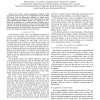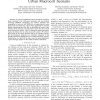105
click to vote
VTC
2010
IEEE
14 years 11 months ago
2010
IEEE
—This paper investigates the performance of time interleaving in DVB-T2 in the context of mobile reception. By means of time interleaving it is possible to provide time diversity...
VTC
2010
IEEE
14 years 11 months ago
2010
IEEE
—We analyse mobile propagation channels which occur in the context of car-to-car communications in the 24 GHz ISM band. From the information gathered, we design robust frame desi...
101
click to vote
VTC
2010
IEEE
14 years 11 months ago
2010
IEEE
Abstract—In this paper, randomized distributed spacefrequency coding (R-DSFC) scheme is proposed for decentralized wireless relay networks. We consider relay-assisted ARQ to over...
116
click to vote
VTC
2010
IEEE
14 years 11 months ago
2010
IEEE
—This paper exploits the use of location information of wireless terminals to improve the performance of a beamforming system and support multiple access. Based on a system provi...
110
Voted
VTC
2010
IEEE
14 years 11 months ago
2010
IEEE
Abstract— Mobile radio networks of the IMT-Advanced systems family promise ubiquitous broadband access and high area coverage, with rates of several 100 MBit/s. They claim to gua...
115
click to vote
VTC
2010
IEEE
14 years 11 months ago
2010
IEEE
—We present the ǫ-outage capacity in the low signal-to-noise ratio (SNR) regime of an incremental relaying network. The network consists of one source, one destination, and two ...
129
click to vote
VTC
2010
IEEE
14 years 11 months ago
2010
IEEE
—In this paper we present an architectural analysis of a smart DMA (sDMA) controller for protocol stack acceleration in mobile devices supporting 3GPP’s Long Term Evolution (LT...
105
click to vote
VTC
2010
IEEE
14 years 11 months ago
2010
IEEE
—In this paper, we introduce a collision model for vehicular cluster and we propose path selection algorithms for multi-hop VANETs. That is, we propose the intuitive algorithm na...
70
Voted
VTC
2010
IEEE
14 years 11 months ago
2010
IEEE
104
click to vote
VTC
2010
IEEE
14 years 11 months ago
2010
IEEE
—A common simplification in the treatment of random linear channels is the wide-sense stationary and uncorrelated scattering (WSSUS) assumption. For wireless channels, this assu...





